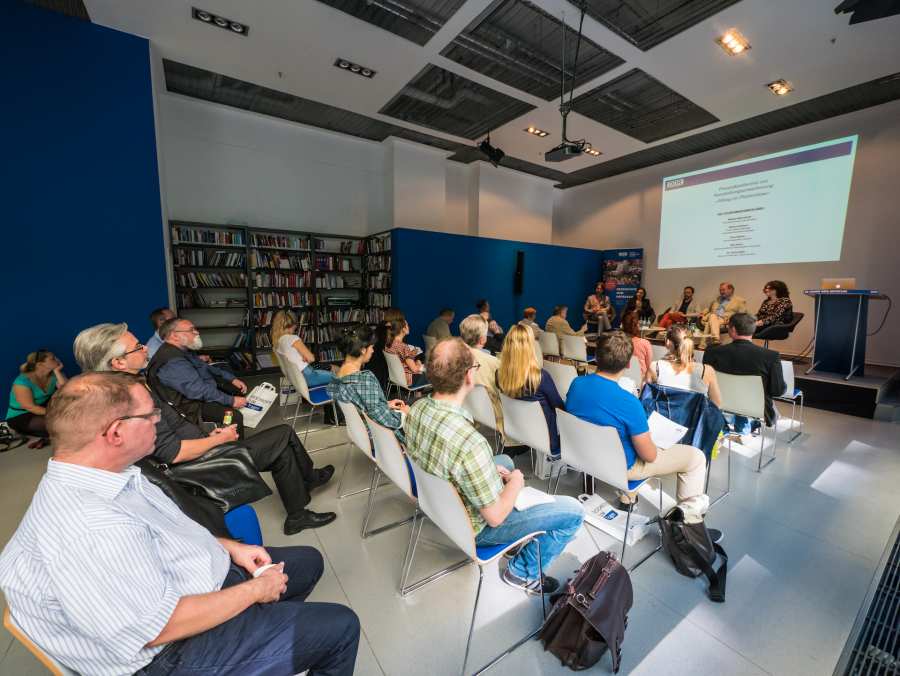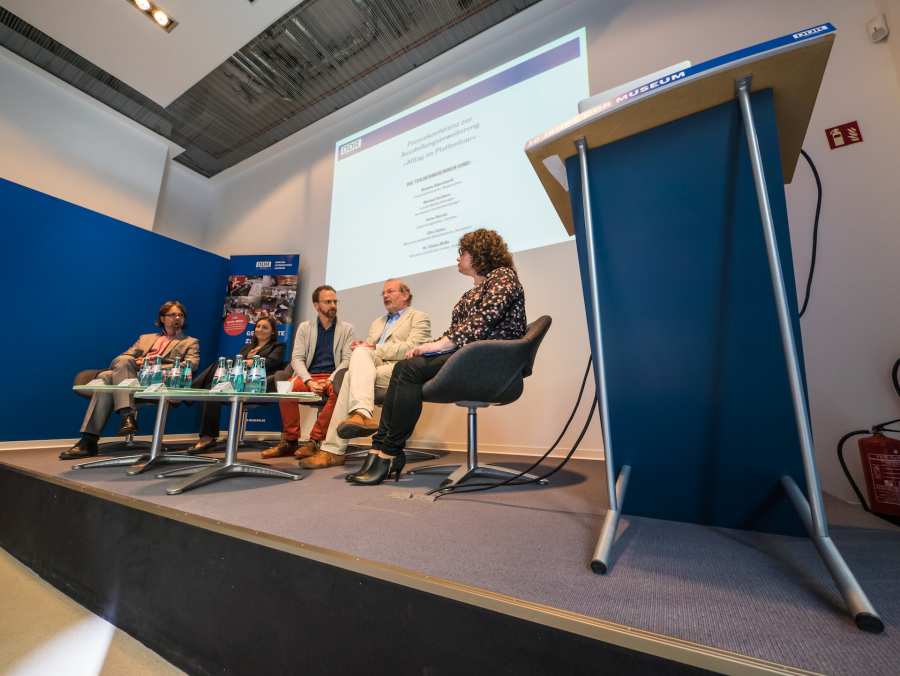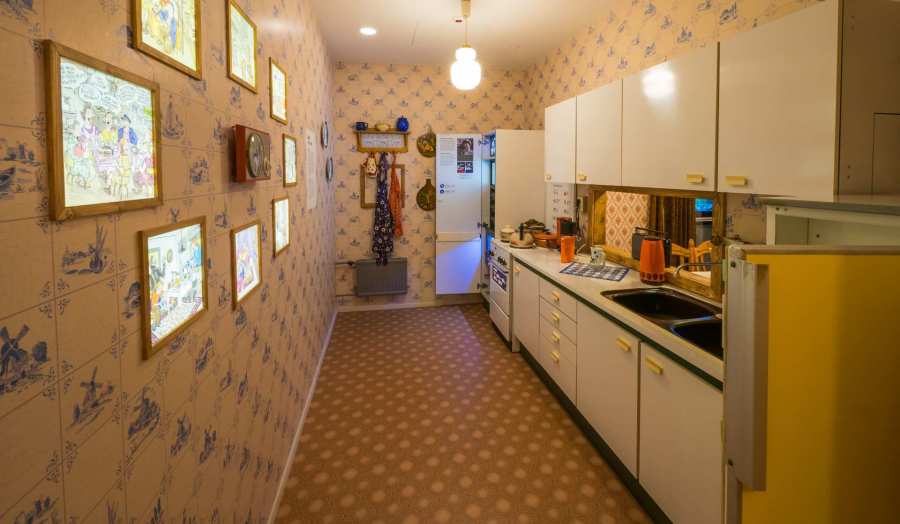Event
Press conference for the opening of the new exhibition „Everyday life in the Plattenbau”
(24 Aug 2016)
Last Friday, August 19th 2016, a press conference took place at the DDR Museum on behalf of the opening of the new permanent exhibition on August 27th 2016, in the context of the Lange Nacht der Museen in Berlin. The long period of preparation is now almost over and we are looking forward to show even more of a hands-on experience of history on additional 270m²!
After 1 1/2 years of planning opening on August, 27th 2016
For a long time we have been planning, conceptualizing and implementing – in 6 days, however, the time has finally come: A new part of our permanent exhibition will be opened for our visitors. The museum therefore invited representatives of the local press to a press conference and an ensuing exclusive tour of the exhibition. Numerous journalists as well as representatives of the Berlin culture scene followed the invitation and took part in the event.
Staff members of the DDR Museum on the podium were the head of PR Melanie Alperstaedt, the curators Elke Sieber, research assistant, Dr. Stefan Wolle, head of research as well as Sören Marotz, head of collections. Michael Geithner, the social media manager of the museum and responsible for the interactive design, also took part in the conversation.
After a short greeting by the director of the museum, Mr. Gordon Freiherr von Godin, Dr. Wolle began with an introduction into the project. The decision for creating a new exhibition was based on the high number of visitors which the DDR Museum is greeting every single day. The formerly attached restaurant “Domklause” was therefore closed in spring 2015 in order to turn the premises into exhibition space. During the conceptual planning period it was decided to show the private aspect of life in the GDR within the new exhibition, along with all its facets, contradictions and difficulties. An authentic flat of the WBS70 series was therefore built for this purpose. In the GDR, the flat was a sort of “save room” where politics and ideology played – if at all – merely a minor role and represented a place where one could retreat to with family and friends.
Interactivity and technological highlights
The goal of the exhibit is to tell the story of the people with the help of objects, pictures and games as vividly as possible. The method of interaction, which has also been used for the already existing exhibition parts, will also be applied in order to make the show attractive for visitors of all age groups. The main focus is undeniably on the numerous authentic objects which are contextualized with the help of presentation, technical installations and playful elements. According to Dr. Wolle, the DDR Museum is neither a memorial site nor a pilgrimage site for “Eastalgia”. It is rather a place of learning which is also meant to be fun. The museum’s mission is to educate about the Socialist dictatorship by applying a certain dose of irony which was also characteristic for the society of the GDR. The focus is therefore not so much on the spectacular but rather on the representative averageness of everyday life in the GDR.
The introduction was followed by some explanations concerning the technological highlights of the exhibition by Michael Geithner. One of them is a digital mirror which lets the visitors try on authentic clothes from the GDR. Another special installation is the coffee table in the living room which the visitors can operate via touch technology in order to choose the TV program on the TV set across the room. The DDR Museum is especially proud of the fact that most technological installations have been designed exclusively for our exhibition and are therefore unique.
Furthermore, the principle of interactivity has also been applied during the planning period: Members of our social media community were asked to vote on the floor and wallpaper designs as well as on popular songs of the GDR which can now be heard within the exhibit. Following the conference, all guests took the chance to take part in the exclusive tour with the curators. It was a good opportunity to get into conversation with the director or other present staff members. The overall impression was truly positive; the many playful elements of the exhibit as well as the authentic presentation were especially popular among the first visitors.
Opening of "Everyday life in the Plattenbau" and special exhibition "Extravagance"
Next Saturday, August 27th 2016, will be the day: the new part of our permanent exhibition will finally be opened for our visitors. The DDR Museum will also open the special exhibition “Extravagance in the GDR” in the context of the Lange Nacht der Museen. We are looking forward to your visit!
Press coverage
Some reactions from the press:
“Six rooms are covering 270m² of exhibition space which are following the museum’s motto of a hands-on experience of history and are inviting to participate, try out and discover.” – fotoausstellungen.com
“In the completely furnished Plattenbau flat, every visitor can travel back to the 1980s.” – Focus
Curators:
Dr. Stefan Wolle, head of research
Elke Sieber, research assistant
Sören Marotz, head of collections
Contributors:
Consulting and interactive design: Michael Geithner
Texts: Dr. Stefan Wolle, Tilman Birr, Elke Sieber
Translations: Andrew Smith
Graphics and design: Constantin Bänfer, Jonas Kartenbeck
Digital wardrobe, digital windows: ravir film (Dresden)
Dioramas and models: Holger Delfs
Architect: Frank Wittmer
Exhibition construction: Martin Bauer
Facts:
Size: ca. 270m² additional exhibition space, total of 930m²
Investment sum (including planned alteration in 2017): ca. 1,1 Mio Euro
Time span from first idea until opening: 1 ½ years
Surveys on social media platforms on the following topics:
Design of wallpaper
Design of floor
Songs for the listening station in the living room


